I wanted to look into raccoons more because of the way that they’re structured but also the way that society has a very controversial outlook into the creatures.
Raccoons are often seen as vermin but then other members of society associate raccoons as “Trash pandas” and are often adored. Raccoons have also been known to be kept as pets which again is a controversial idea.
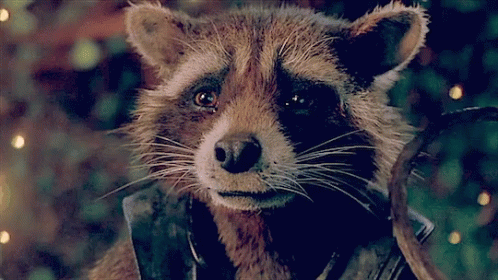
About Raccoons:
Raccoons have a mix range of characteristics that seem to range between being a fun-loving pet to a stupid and confusing character.
Raccoons are also known for having a mischievous and curious outlook at life and objects. However they are also known for being smart, intelligent creature with good memory and are able to solve puzzles (unlock door and twist the lid of jars!) which is why they get the name for mischievous behaviours.
They are also excellent climbers and will seek refuge in high up places if needed. They are able to climb down a tree face down which is a challenge in itself for a human anyway. Other than the climbing they are also excellent swimmers who love water however they will only swim into the deeper water if they need to in order to survive.
However they can be territorial when it comes to the family groups/ gaze (a gaze is a group of raccoons). They have been known to be aggressive however that is only when they feel threatened and or being territorial.
Raccoons are also known for being independent after the ages of 12-14 months which then they will grow up to be apart of a knit community which consists of 4-5 raccoons which are a sort of protection against predators.
From the social interaction it leads to the language of raccoons. They communicate with each other using over 200 different sounds and 12-15 different calls which range between screams, snarls, growls, whistles and hisses.
One of the things about raccoons is that they have poor eyesight and have poor long-distance vision and are often thought to either struggle distinguishing colour or are just plain colour blind animals. However due to the lack of one of the senses, their hearing and touch make up for it making it their most predominant senses.
Raccoon habitats are of a verity of locations. They are native to North and Central America and have been known to be present within parts of Asia and Europe. Raccoons are extremely adaptable when it comes to living, they have a preferred habitat mainly being marshes, swamps and flooded forests or even mangroves. But are known to inhabit anything as long as they have access to water including suburban areas. They also have a habit of creating dens in different ranges of places, including, tree holes, banks, in ground burrows or log piles and attics.
Raccoon are mistaken for hibernating which is wrong. Instead raccoons do disappear of to the their dens but it would only be for a few weeks at a time only in winter. When in the den they will enter a state called torpor which means they will lower their body temperatures and metabolism which in turn will reduce their use of energy and their food uptake, which is why they will only disappear for a few weeks at any certain time during winter.
Even though raccoons are very picky about living near swamps they also have a mistaken sense of OCD. They have a weird cleaning habit, their front paws are extremely sensitive to couch and have a special type of hair that is located above their non-retractable claws (similar to cats whiskers) which mean that raccoons don’t even need to tough the object to locate them. Because of this many believed that raccoons used to wash their food but instead it has been proved that because their paws are more sensitive to touch, when they’re wet they can with take more information in when they are rubbing their food which is why it can get mistaken for washing their paws and food.
Raccoons are classed as omnivores but can survive on a flexible diet which consists of plant food and meat. They are also the type of mammal that are opportunistic and will take whatever they can get which means food that is close to or on the floor/ ground. So this includes some of the following:
- reptiles
- mammals
- fish
- fruit and nuts
- eggs
- and insects.
And in certain parts of the suburbs it could include rubbish.
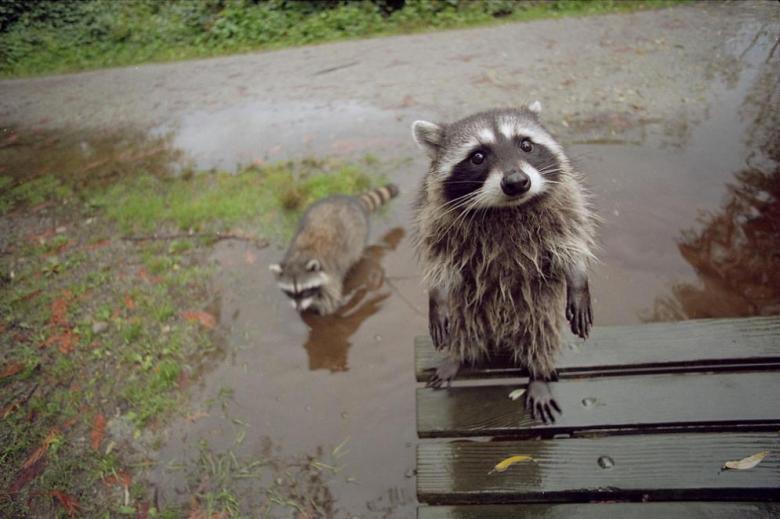
Why am I choosing a raccoon?
One of the main reasons that I choose to research and sculpt a raccoon is because of the way the creature is portrayed. I want to show the side which is the fun, playful, curious and adventurous creature.
I also looked into the skeleton of the raccoon and became fascinated with the way that a raccoons skeleton is structured compared to the way that they have less restrictions over certain muscles. I find it intriguing when looking at a raccoon and some of the photos that are around and how they can almost appear in a human structure.
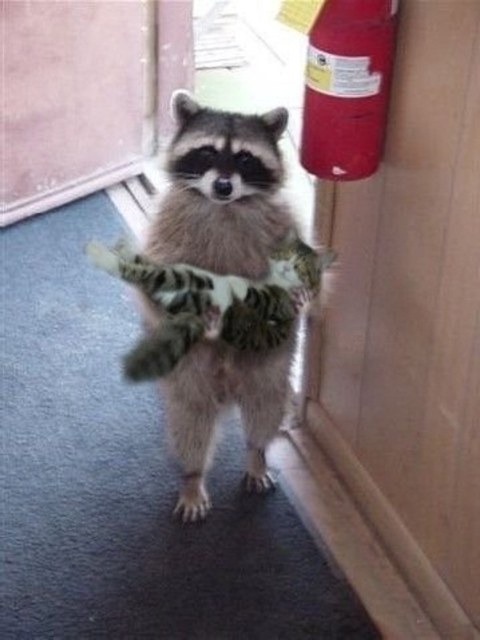 This picture really makes me uncomfortable because of the way that the raccoon resembles so much of a human. The way that its on its hind legs and CARRYING A CAT!!! A CAT. THE RACCOON IS CARRYING THE BLOODY CAT!!! I don’t know why it freaks me out but it does. So I thought that maybe I could use it to show the different postures a raccoon would withstand.
This picture really makes me uncomfortable because of the way that the raccoon resembles so much of a human. The way that its on its hind legs and CARRYING A CAT!!! A CAT. THE RACCOON IS CARRYING THE BLOODY CAT!!! I don’t know why it freaks me out but it does. So I thought that maybe I could use it to show the different postures a raccoon would withstand.
I also thought about doing a raccoon because when it comes to the market research I thought of an idea which influenced me to do raccoons. I had a thought of a raccoon stood by a bin with a picnic basket that was full of litter/ rubbish and it was supposed to show the raccoon cleaning up after itself (I thought it would be a good influence and message to always bin things and not littler basically).
Photographic evidence.
Unfortunately I cannot find a raccoon within a local radios. I do however have a cat that looks and behaves very similar to one…
My cat Burt will substitute for now. I mean in all honesty, he was a stray that adopted me as its owner and the way he behaves is of a similar nature. His colour or his fur and the way that his tail is slightly ringed and how he has a darker patch around his eyes (not black like a raccoons) but he still reminds me of one.
So because I cant find any I had a look on google images but I also found a channel on youtube about a pet raccoon and they way that that one moves.
I found these images that are of a raccoon stuck in a bin useful for reference for the structure of pose and position. But I also found it interesting because its one of the ideas that I had for the project.
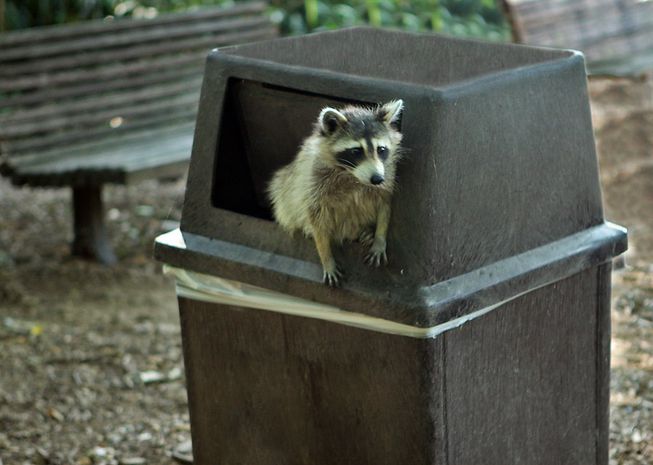 When I saw this picture I thought it was a good picture because it captures the playfulness and also the curiosity of the animal.
When I saw this picture I thought it was a good picture because it captures the playfulness and also the curiosity of the animal.
Because of this I had decided to look into the different emotions that a raccoon shows.
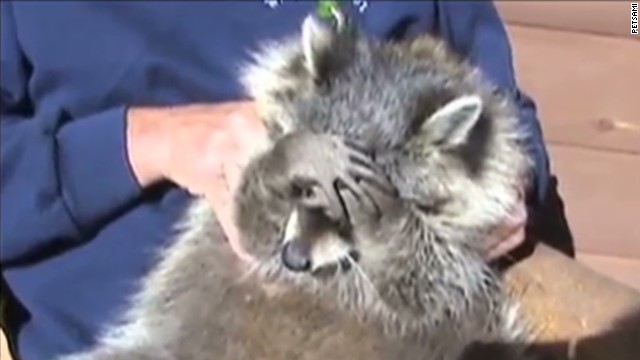 The picture above can be interoperated in two different ways. It can show that the raccoon is either scared and is trying to hide his face with his eyes which is also a human behaviour. Or it can mean they’re are being playful and almost mimicking a “PEEK-A-BOO” behaviour.
The picture above can be interoperated in two different ways. It can show that the raccoon is either scared and is trying to hide his face with his eyes which is also a human behaviour. Or it can mean they’re are being playful and almost mimicking a “PEEK-A-BOO” behaviour.
 The raccoon above is wearing a smile and seems to be a happy cappy. His eyes seem wider than normal and are slanting one of his ears which is a sign of subsistent behaviour but also a playful and content sign. He seems to be happy and almost a little excited to be where he is.
The raccoon above is wearing a smile and seems to be a happy cappy. His eyes seem wider than normal and are slanting one of his ears which is a sign of subsistent behaviour but also a playful and content sign. He seems to be happy and almost a little excited to be where he is.
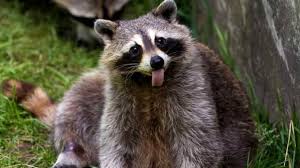 The image is a raccoon sticking his tongue out which is very positive and almost excitable and playful. His eyes are wide again and his head is slightly tinted which I suppose is similar to a puppy when they get excited and have a slant with their head when trying to play.
The image is a raccoon sticking his tongue out which is very positive and almost excitable and playful. His eyes are wide again and his head is slightly tinted which I suppose is similar to a puppy when they get excited and have a slant with their head when trying to play.


I put these pictures together because I felt like they had a very similar emotive and feeling behind it which to me I thought close enough to group them together. The emotion I get off these images are a very angry and defensive state. The snarl look, the way its showing his teeth, the way that his nose has crinkled up and his eyes have slanted nearly to the point they have closed. They all show towards a very territorial and aggressive manor.

This is one of the last pictures I could find of a raccoon showing emotion. It shows almost a thankful but surprised look. The pose of him being sat on his hind legs with his front paws on his face almost mimicking a shocked look. But also the way that his eyes glistening almost as if he is welling up and nearly crying.

